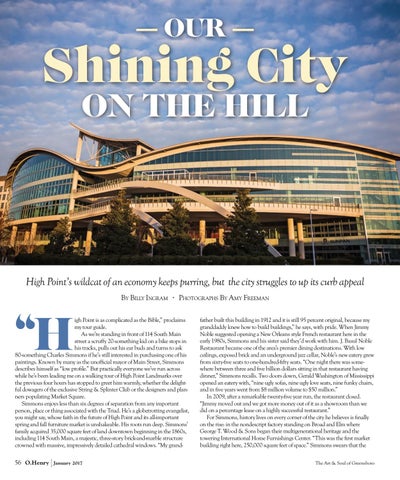— OUR —
Shining City ON THE HILL
High Point’s wildcat of an economy keeps purring, but the city struggles to up its curb appeal By Billy Ingram • Photographs By Amy Freeman
“H
igh Point is as complicated as the Bible,” proclaims my tour guide. As we’re standing in front of 114 South Main street a scruffy 20-something kid on a bike stops in his tracks, pulls out his ear buds and turns to ask 80-something Charles Simmons if he’s still interested in purchasing one of his paintings. Known by many as the unofficial mayor of Main Street, Simmons describes himself as “low profile.” But practically everyone we’ve run across while he’s been leading me on a walking tour of High Point Landmarks over the previous four hours has stopped to greet him warmly, whether the delightful dowagers of the exclusive String & Splinter Club or the designers and planners populating Market Square. Simmons enjoys less than six degrees of separation from any important person, place or thing associated with the Triad. He’s a globetrotting evangelist, you might say, whose faith in the future of High Point and its all-important spring and fall furniture market is unshakeable. His roots run deep. Simmons’ family acquired 35,000 square feet of land downtown beginning in the 1860s, including 114 South Main, a majestic, three-story brick-and-marble structure crowned with massive, impressively detailed cathedral windows. “My grand-
56 O.Henry
January 2017
father built this building in 1912 and it is still 95 percent original, because my granddaddy knew how to build buildings,” he says, with pride. When Jimmy Noble suggested opening a New Orleans style French restaurant here in the early 1980s, Simmons and his sister said they’d work with him. J. Basul Noble Restaurant became one of the area’s premier dining destinations. With low ceilings, exposed brick and an underground jazz cellar, Noble’s new eatery grew from sixty-five seats to one-hundred-fifty seats. “One night there was somewhere between three and five billion dollars sitting in that restaurant having dinner,” Simmons recalls. Two doors down, Gerald Washington of Mississippi opened an eatery with, “nine ugly sofas, nine ugly love seats, nine funky chairs, and in five years went from $8 million volume to $50 million.” In 2009, after a remarkable twenty-five year run, the restaurant closed. “Jimmy moved out and we got more money out of it as a showroom than we did on a percentage lease on a highly successful restaurant.” For Simmons, history lives on every corner of the city he believes is finally on the rise: in the nondescript factory standing on Broad and Elm where George T. Wood & Sons began their multigenerational heritage and the towering International Home Furnishings Center. “This was the first market building right here, 250,000 square feet of space.” Simmons swears that the The Art & Soul of Greensboro
